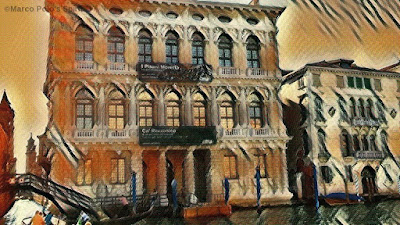The complete insider's guide to Venice and Venice Carnival
 |
| The Insider' guide to Venice |
Are you going to Venice and attend Venice Carnival this year, and you need to find an insider's guide to get organised? At Carnival an Italian saying goes: "A Carnevale ogni scherzo vale", that is at Carnival any tricks goes.
The last thing you want is the Carnival hustle and bustle playing tricks on you. After all with millions of tourists visiting Venice for the Carnival, who said that going to Venice Carnival is an easy job?
During the fourteen days of the Carnival, Venice fills with tourists from all over the world who join in to live together this unique opportunity. They want to experience the city all decked up in its spectacular party costumes, traditional masks and the revival of old traditions.
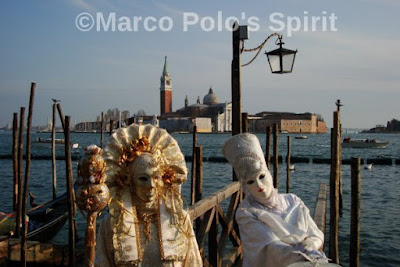 |
| Stunning masks on the water of Venice Grand Canal |
To be honest, Carnival does not rank first in Venetians' hearts. I have mixed feelings about this event too. Venice becomes a bit of a mess in the most crowded days. However, forgetting old traditions completely is forgetting one's culture. Venice Carnival is 800 years old, and it has always been deeply rooted in history.
Here is my insider's guide to visit this fascinating Venice at Carnival without spoiling your holidays and avoiding tourist traps.
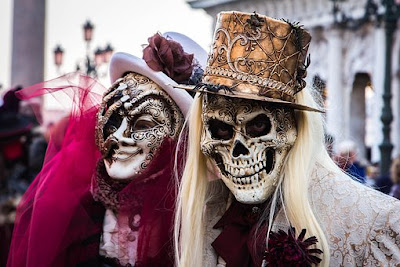 |
| Venice incognito: dressed to kill? |
You will find information on:
- BEST DAYS TO GO
- FREE EVENTS
- PAID EVENTS
- CARNIVAL FOR CHILDREN
- CARNIVAL ORIGINES, COSTUMES AND MASKS
- FOOD AND MY FAVOURITE PLACES TO EAT
- SHOPPING
- 8 TOP TIPS TO AVOID HASSLES AND MISHAPS
- GETTING THERE AND AROUND
BEST DAYS TO GO
Every year the Carnival dates change. In 2018 the period goes from Saturday 27th January 2018 until Wednesday 14th February 2018. The best days to take part depend on your personal tastes.
The first week is quieter with less events. However, you can enjoy the fun without the crowds. The pros are: the city is easy to walk through, public toilets are clean, restaurants are less packed and you will avoid long queues for the vaporettos, the local water buses. The cons are: the Carnival vibe is less felt, and probably you will have less masks posing for photo sessions in Saint Mark's Square.
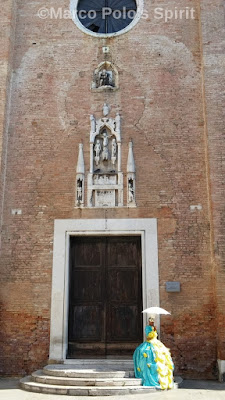 |
| Venetian mask with sun umbrella posing outside Sant'Aponal Church |
If you are looking for the real frenzy, serious fun, and thousands of masks, choose the second week, in particolar the weekend.
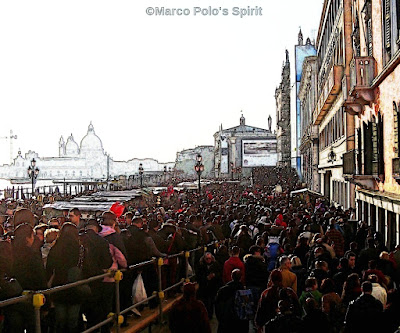 |
| Crowds on Venice waterfront in the busiest days |
There are also two important dates to remember: "Fat Thursday" (in Italian, giovedì grasso) on 8th February 2018, and "Fat Tuesday" (in Italian, martedì grasso) on 13th February 2018. The events on those date are very popular in Italy, especially with families and children, because Italian schools break for Carnival.
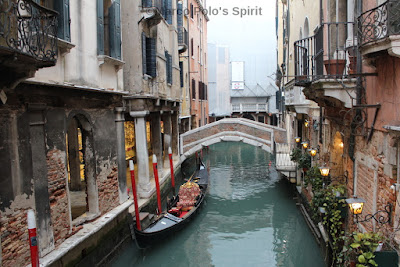 |
| Empty gondola moored by the side of a small canal |
FREE EVENTS
Most of the thrilling shows are free of charge, that is why they are always crowded. All the events are spread across the city districts called "Sestieri". The Carnival events focus on the following Sestieri: Cannaregio, Dorsoduro, San Polo, San Marco and Castello. However, the main celebrations occur in Saint Mark's Square.
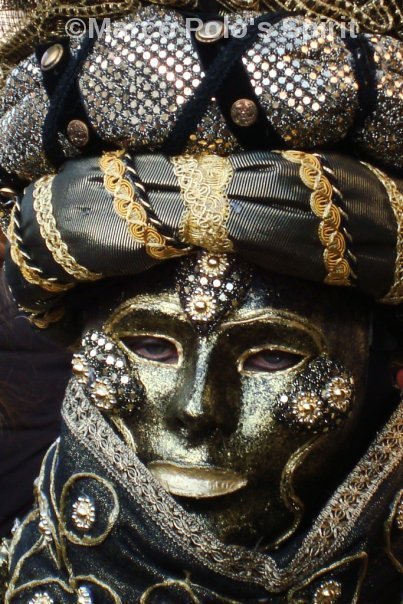 |
| Black and golden mask watching the Carnival show |
The list of free events is long, but I suggest you attend the following:
OPENING WATER SHOW: on Saturday 27th January 2018 the Carnival opens with an amazing parade along the Rio Cannaregio (Sestiere of Cannaregio), just 10 minutes off Santa Lucia train station. The show will be staged twice at 6 pm and 8 pm. My tip: go there early.
What's the hightlight? Every year the Carnival theme changes and the theme for 2018 is "Civitas Ludens" (the community that plays): the Circus. During the show, acrobats and clowns will stage circus attractions of the past century, bringing to mind Fellini's films and circus arts. The performance will take place on water platforms!
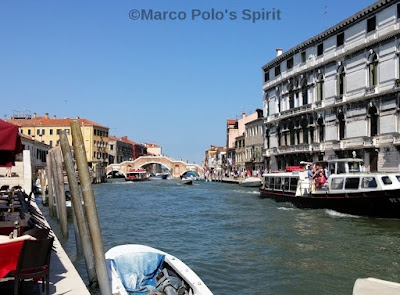 |
| Rio Cannaregio where the Carnival water show will take place |
SOME PHOTOS OF 2018 OPENING WATER OPENING SHOW
Here you can enjoy some pictures from the opening party, staging Fellini-like circus scenes with 11,000 people watching the show from the Cannaregio river shores.
 |
| Crowd clumped on the Rio Cannaregio bridge waiting for the show to begin |
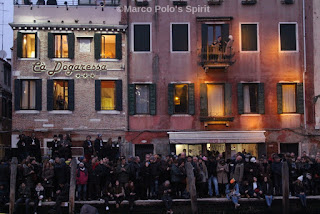 |
| People sitting on the Rio Cannaregio bank |
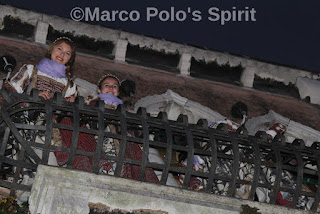 |
| Beautiful dames with masquerade looking out onto the Rio Cannaregio |
 |
| Venice Carnival pays homage to the Italian film-maker Federico Fellini through Circus scenes |
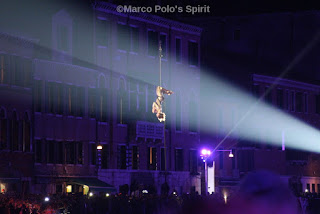 |
| Acrobat over the Rio Cannareggio during her performance |
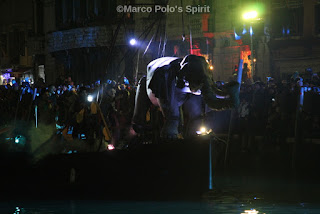 |
| Elephant mock up puppet at the show |
 |
| Giraffe mock-up |
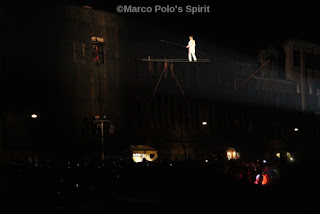 |
| Tightrope walker over Rio Cannaregio |
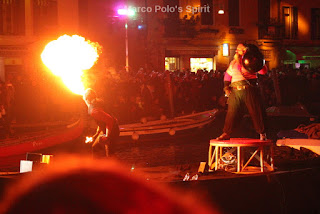 |
| Fire eater and strongman |
WATER PARADE AND THE COLUMBINA SPRINT REGATTA: on Sunday 28th January 2018 two big events will take place: at 11 am a water parade will cross the Grand Canal from the Punta della Dogana (the Custom's House in the Sestiere of Dorsoduro) to end up in Rio Cannaregio (Sestiere of Cannaregio).
At 10.30 am for the rowing boat fans, there is also a rowing competitive race with traditional Venetian boats called "gondolini", small gondolas rowed by women. They will row their boats (not so) gently down the Rio Cannaregio. Life in Venice is but a dream!
Tip: at 12 am the local associations and the municipality will host a buffet.
 |
| Rowing boat competition on the Grand Canal |
BEST MASK COMPETITION: if you are proud of your Carnival outfit and you have a competitive spirit, you can register for the most beautiful mask competition which will be held daily in Saint Mark's Square. The official jury will select the winner on Sunday 11th February 2018. To register for the competition, click here.
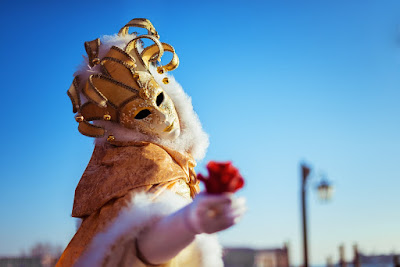 |
| Mask in Saint Mark's Square holding a rose |
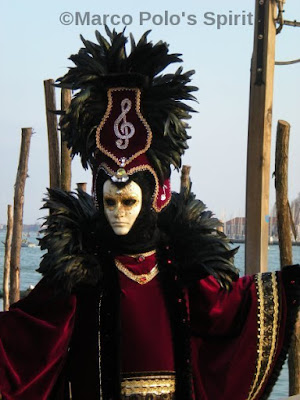 |
| Devil fancy dress mask |
PARADE OF THE TWELVE MARIAS: on Saturday 3rd February 2018 from 2 pm a traditional parade of twelve young girls called Marias will set off from the Church of San Pietro di Castello (Sestiere of Castello). The Marias' parade will cross the city to get to Saint Mark's Square (2.5 km). Among the twelve young girls who take part, one will be crowned the final winner.
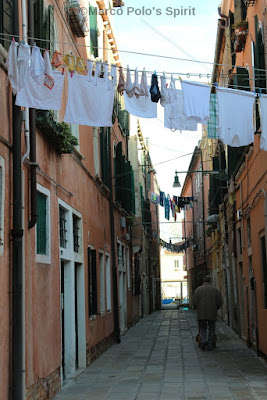 |
| San Pietro di Castello district is the most authentic part of Venice to visit |
The story of this unique parade goes back to the IX century: the story goes that all the would-to-be Venetian spouses would be blessed with a special ceremony at the beginning of February each year. Among them, the twelve pooorest women would be selected to dress up with the best attires and jewels lent by the city churches. During one of those parades, it is thought that pirates abducted them. However, Venetians saved them, and to remember this fact, the Marias' parade is staged.
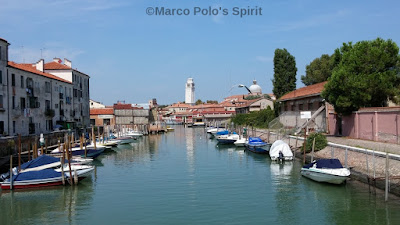 |
| San Pietro di Castello area from where the Marias' parade will set off |
THE FLIGHT OF THE ANGEL: on Sunday 4th February at 11 am the girl who won the Marias' competition the previous year will be "flying" from Saint Mark's Square bell tower. The brave girl will hoover over the heads of the jam packed Saint Mark's Square. She will be tied onto a metal cable. Her flight will end up in the arms of the Venetian Doge (the head of the Republic of Venice) and parading with him across the Square.
Updates: the access to Saint Mark's Square will be limited to 20,000 visitors.
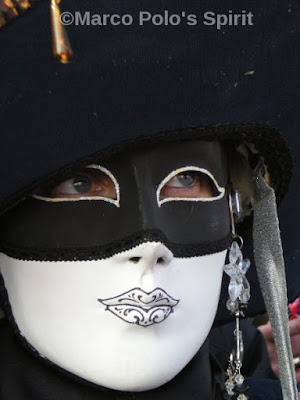 |
| Black mask in Saint Mark's Square looking up towards the bell tower |
THE FLIGHT OF THE EAGLE: on Sunday 11th February 2018 at 12 am another spectacular flight will take place in Saint Mark's Square. This time the shows is called "Il Volo dell'Acquila", the Eagle's flight and unlike the previous event, the flight will be performed by an artist.
THE HISTORY OF CARNIVAL THROUGH PAINTINGS: on 9th and 10th February 2018 the Querini Stampalia museum will offer free guided tours on the history of Carnival thorugh the museum painting. Booking is needed. For more information, click here.
PAID EVENTS
OFFICIAL DINNER SHOW AND BALL: if you want to experience a sort of "Eyes Wide Shut" thrill, and you can afford it, book the official dinner parties. They are staged in Ca' Vendramin Calergi, one of the most beautiful palaces on the Grand Canal where Richard Wagner used to live and compose. Dress code: masked.
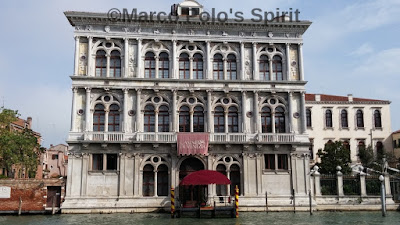 |
| View of Cà Venramin Calergi from the Grand Canal |
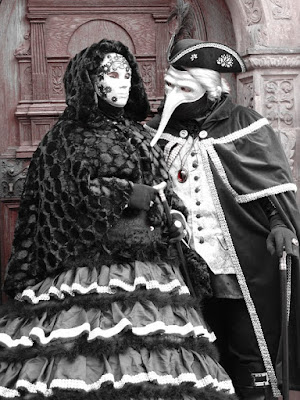 |
| Ready for the Grand Ball |
ARSENAL CARNIVAL EXPERIENCE: if you fancy a bit of night life, head to the Arsenale (the old ship dockyard of Venice) in the Sestiere of Castello. From 9th February 2018 to 13th February 2018 three huge pavillions will become the night hub with live music and dj sets. Music from 23 pm to 3 am.
For more information on the Carnival events, click here.
CARNIVAL FOR CHILDREN
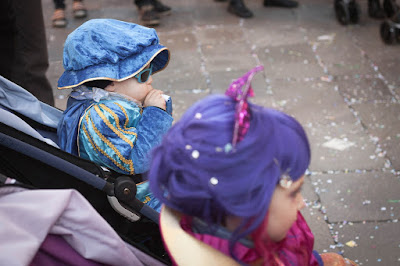 |
| Children dressed up for Carnival in their pushchairs |
ICE-SKATING RINK: if your children enjoy skating in Campo San Polo (Sestiere of San Polo), there is an ice rink opened daily until 14th February 2018. At a charge.
CHILDREN'S BEST MASK: on 12th February 2018 in the morning your children can parade with their best masquerade wigs and outfits on Saint Mark's Square.
Tips: if you have prams or pushchairs, take the lightest children's buggy you have. Bear in mind you will need to cross over many bridges, flight of steps and uneven pavements. For toddlers or young children, use a children's sling carrier!
FREE GUIDED TOURS AT PEGGY GUGGENHIM MUSEUM: the museum has a wide choice of free activities for children in English too. Kids can find interesting activities from 27th January 2018. Educational activities are free, but you need to purchase the entry ticket. For more information, click here.
 |
| Light blue Venetian mask, so sophisticated and cunning! |
CARNIVAL ORIGINS, COSTUMES AND MASKS
The Carnival was set up officially in 1296 by the Senate of the Republic, and it would last for months. Venetians would build stages in the main campos (the squares in the Venetian dialect) and would enjoy the crazy atmosphere together with jesters, acrobats and stilt walkers.
In XV century the Venetian Republic turned a blind eye to any kind of social behaviour during the Carnival period which was very libertine. Venetians would put on masks and dressed up to hide their face in public which was allowed only during Carnival.
Many Carnival attractions were actual competitions and shows of strength, such as the human tower competitions or the fire pinwheel. If you are curious to learn about what these attractions looked like, head to Museo Correr on Saint Mark's Square to see the social games and entertainments at that time.
Many Carnival attractions were actual competitions and shows of strength, such as the human tower competitions or the fire pinwheel. If you are curious to learn about what these attractions looked like, head to Museo Correr on Saint Mark's Square to see the social games and entertainments at that time.
In the past the Carnival celebrations would go on for weeks until the bells of the Church of San Francesco della Vigna (Sestiere of Castello) would ring the death knell to announce the start of Lent, that is 40 days before Easter. The end of the Carnival.
In 18th century Venice was the capital of pleasure and the nobles from all over Europe used to attend the Carnival to vent out their insticts. If you want to find out more about how Venetians had fun, another excellent suggestion is visiting the Longhi room in the Ca' Rezzonico Museum (Dorsoduro 3136).
In 18th century Venice was the capital of pleasure and the nobles from all over Europe used to attend the Carnival to vent out their insticts. If you want to find out more about how Venetians had fun, another excellent suggestion is visiting the Longhi room in the Ca' Rezzonico Museum (Dorsoduro 3136).
According to past traditions, the Venetian masks are the following:
BAUTA: it was the white mask worn by men. The lower part of the mask is open, so one can eat, speak and drink without taking it off! The "bauta" includes the mask, the tricorne hat and the cape.
COLUMBINA: it is the used by women and it does not cover all the face. Columbine was also the character of a servant in the Italian Commedia dell'Arte, and Harlequin's mistress.
GNAGA: it is a cat-like mask which leaves the mouth uncovered. The name "Gnaga" comes from the sound that cats make. It used to be worn by men who wanted to wear women's clothes: they could not be arrested as during Carnival a person was just playing a role!
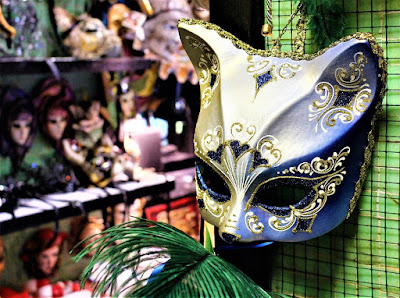 |
| A gnaga mask in a Venice shop: she claws her way into your heart |
HARLEQUIN: it is the mask representing the asture servant in the Italian Commedia dell'Arte. He wears multicoloured jackets and trousers.
LARVA/VOLTO: this is the most common mask nowadays. It can be worn by men and women and covers the whole face. This mask is mysterious and emotionless.
PANTALONE: it is a mask of the Italian Commedia dell'Arte. It is the mask of an old merchant, greedy and lavish. The man wears a dark cape and red trousers. The mask nose is hooked.
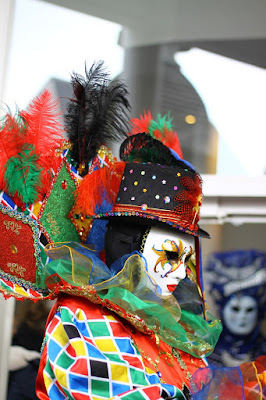 |
| The astute servant Harlequin |
LARVA/VOLTO: this is the most common mask nowadays. It can be worn by men and women and covers the whole face. This mask is mysterious and emotionless.
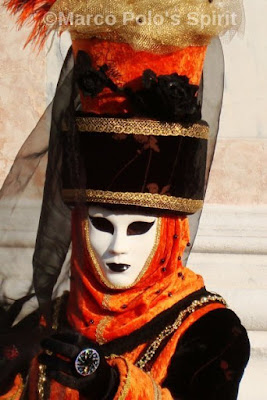 |
| Larva or volto mask is one of the most common masks |
PANTALONE: it is a mask of the Italian Commedia dell'Arte. It is the mask of an old merchant, greedy and lavish. The man wears a dark cape and red trousers. The mask nose is hooked.
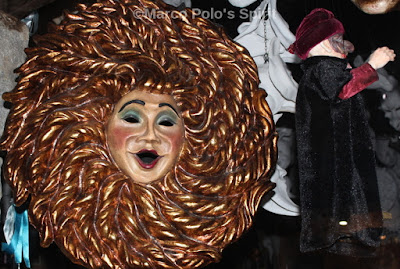 |
| Sun and Pantalone masks in a shop window |
PLAGUE DOCTOR: it was the mask which doctors would actually put on to avoid sniffing the bad smell of diseases. To do so, they would put strong substances in their masks such as lavander.
ZANNI: it is the mask with a long-pointed nose. It belongs to the character of the village idiot. The longer the nose, the less clever he is.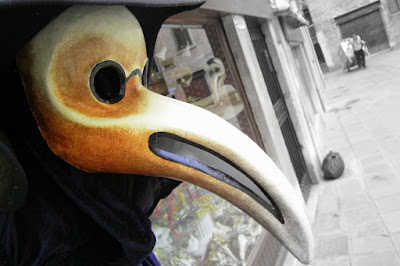 |
| Plague doctor mask: how did they manage to operate with that beak? |
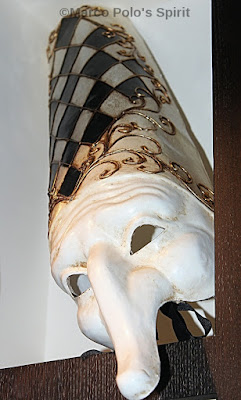 |
| The village fool: Zanni mask with a long nose |
FOOD AND MY FAVOURITE PLACES TO EAT
FOOD: FRITTELLE AND GALANI
You can't say "Carnevale" without eating the traditional Venetian pastries: "frittelle" and "galani". The fritelle are sweet fried dumplings made of flour, eggs, water, sugar, and raisins. Some are plain, others are filled with cream or eggnog. There are also other variations, such as castagnole (definitely harder).
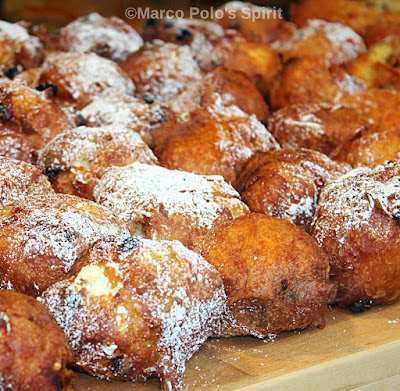 |
| Raise your hand if you can't resist eating frittelle |
The other typical sweet is galani: long crispy stripes of dough that look like ribbons. They are made of butter, flour, water, sugar, deep-fried and sprinkled with soft sugar powder.
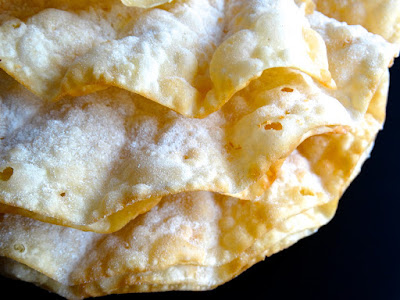 |
| Traditional Venetian galani |
The "pasticcerie" (pastry shops) in Venice which rank among my favourites in the districts of the Carnival are:
PASTICCERIA TONOLO: they are located in Calle San Pantalon 3764 (Sestiere of Dorsoduro) and they are a landmark. The shop is always crowded, but popping in for a fritola (this is the name of the frittelle in the Venetian dialect) is worth waiting.
PASTICCERIA ROSA SALVA: they own two shops, one in San Marco (Fiubera e Mercerie) and the other shop is located in Campo San Giovanni e Paolo (Sestiere of Castello). The name is well-known to any Venetian and the pastry shop is a cornerstone of Venice. You can't miss it! Click here to view contact information.
 |
| Carnival masks with impressive flower hats |
MY FAVOURITE PLACES TO EAT
Venice is packed with bars, restaurants and pizzerias. I don't recommend you to eat in the area around Saint Mark's Square as prices are high, and the quality is not always the best.
If you want to grab a bite without being ripped off, eat in a "bacaro": a traditional tavern, often very informal where locals eat.
What do Venetians eat in a bàcaro? They eat "cicchetti": small titbits such as boiled eggs with anchovies, fried sardins, local "baccalà mantecato" (whipped salt cod), octopus, salami and pickles, mortadella ham small sandwitches, etc. They are Venice street food.
Venetians match it with "un' ombra" (literally, it means "a shadow"), that is a glass of wine, or with "un birrino", a small beer. Learn "ombra" and "birrino", and you will pass as a local.
There are excellent bacaros spread across the city in each Sestiere. These are some of my top picks divided by Sestiere (district of Venice):
Dorsoduro
BAR LA TOLETTA: this tiny two-room bacaro is located just off the Gallerie dell'Accademia (Dorsoduro 1191). It ranks amongst the top for excellent "tramezzini", the local sandwitches with all sorts of fillings for vegetarians, fish and meat lovers. Go there to sip a cold spritz or to have "una ombra" (glass of wine) and watch the locals lively conversations.
 |
| Tramezzini at Bar Alla Toletta |
Cannaregio
AE BRICOLE: this bacaro located in Fondamenta degli Ormesini (Sestiere of Cannaregio) is very popular with locals. The staff is kind and ready to explain or give food suggestions. Prices are lower than anywhere else, giving the good food quality.
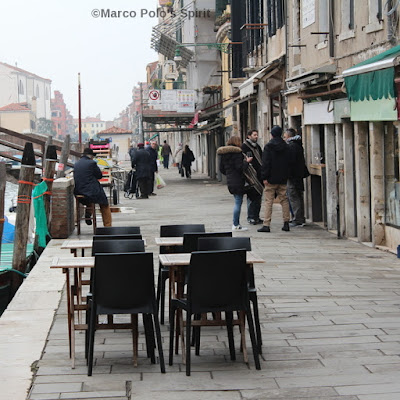 |
| Ae Bricoe attracts many locals for excellent chicchetti and prices |
CAFE DODO: a favourite with Venetians who pack the place for an Aperol Spritz or a quick lunch. They provide breakfast too. You can enjoy your cicchetti sitting on the shore of the canal with the boat passing and the water rinsing.
 |
| Dodo Caffè in Venice: the ideal place to meet locals |
BIRRE DA TUTTO IL MONDO O QUASI: if you fancy a beer and you don't know what to pick, head to this pub in Fondamenta degli Ormesini. They serve beers from all over the world, as well as from local microbreweries.
 |
| Selling beers from all over the world |
OSTERIA BEA VITA: this place was a happy find in Cannaregio 3082, and out of the tourist ways (though not far from the Jewish Ghetto area). Good authentic food is local, so are drinks which are not watered down.
 |
| Osteria Bea Vita with white awnings |
Castello
AL VECIO TRANI: it's a bacaro where you rub shoulders with Venetians. Great porchetta, Aperol spritz and cicchetti. Don't miss it if you are close to the Arsenale. The address is Via Giuseppe Garibaldi 1582. Note that this the only"via" (street) in Venice. All the other street are called "calle"!
San Polo
FRESCH.IN: just for the period 8th February 2018- 10th February 2018 under the loggia of the Rialto Market there will be electronic music and slow food products. |
| View of Rialto Market from the Grand Canal |
A curious annotation: the Venetian dialect word "freschin" cannot be traslated. It is the typical smell that comes from the fish. What better name could be used for an event set in the Rialto market?
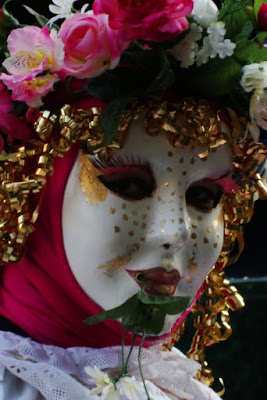 |
| An outstanding spring flower mask |
SHOPPING
PAPUSSE: if you want to buy something which has a long tradition in the Venetian culture, buy the "papusse" (the Venetian dialect word for "slippers"). Today they are made of velvet, but originally they were makeshift shoes, made of discarded bike tyres and tatters. Price: 62 euro.
Gondoliers wore them because the papusse did not scratch the bottom of the boats. You can buy them here at Atelier Nicolao in Cannaregio 2590. In the shop they have been sewing Venetian masquerade costumes since 1980.
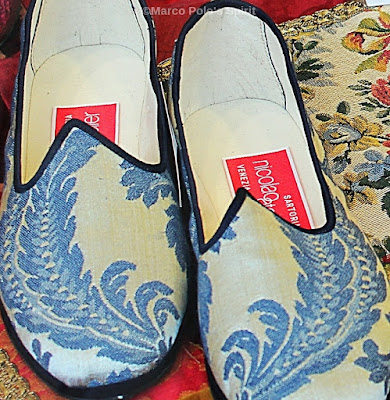 |
| Venetian Papusse, a traditional gift |
HAND-MADE MASKS: head to Ca' Macana Atelier (Dorsoduro 3172). Apart from shopping for masks, you can learn something about the history of Carnival, Venetian masks and witness how they make them. The Atelier holds free lessons on 27th January in Italian and French, and on 28th January 2018 in English and Italian.
Another shop where you can paint and decorate your own mask is called La Bauta.
DESIGN JEWELS: if you find yourself between the Basilica della Salute and Peggy Guggenheim Museum, pop into this glass shop. Maestro Giorgio Nason (Calle del Bastion 167/A Dorsoduro) will show you how he blows life into glass to shape design rings in emerald, ruby and ametiste colours.
 |
| Master Giorgio Nason's glass shop in Dorsoduro |
Another amazing shop for hand-made design jewellery made of metal, glass and pearls is Attombri (Sottoportico degli Orefici, 65 San Polo). Down the Rialto Bridge, on the left hand side of the arched portico, going towards the Rialto market, the designers, the brothers Daniele and Stefano, started their creations in the eighties.
They are inspired by mythology, but their craftwork skills are innovative, matching new and old materials.
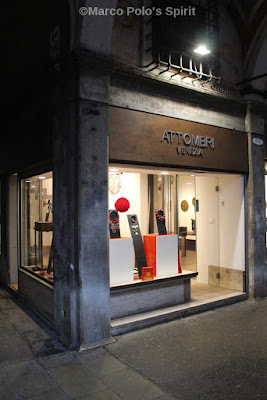 |
| The beautiful Attombri shop at night at the foot of Rialto Bridge |
Another favourite shop of mine is Paperoowl: the designer Stefania who crafts paper jewels studied a whole collection of paper earrings, and necklaces with paper from all over the world. What I love most is the "Inabox" handmade crafts: tiny paper boxes which Stefania turns into marvelous sights of Venice. This year the theme is gondolas and she manages to stick them onto her marvelous origami landscape!
BOOKSHOP-CAFE': after much fun sessions of mask photo shootings, come to this new cosy bookshop-cafè called Sulla Luna Libreria e Bistrot, along Fondamenta Misericordia (Sestiere of Cannaregio).
You can warm up with a hot coffee and leaf thorugh the pages of the books on sale on the bookshelves. You have wide choice to feed your body and your mind at the same time.
 |
| The mask is a real feather in her cup |
10 TOP TIPS TO AVOID HASSLES AND MISHAPS
ACCOMODATION
Find a hotel or bed & breakfast in the Sestieri of Cannaregio, or Santa Croce (the latter is the train station district). Dorsoduro is also perfect. Castello is quiet and authentic; however, it is the furthest from Santa Lucia railway station.
Finding a room close to the train station hekps you to avoid the hassle of luggage carrying. My general advice is: stay away from Piazza San Marco. Generally speaking, prices are soaring high.
Another option is booking a room in Mestre; however, you need to commute every day by bus or by train. Prices are usually slightly lower.
BAGS
Do not go to Carnival with bags or if you do, watch out for pickpockets. Venice is generally safe, but when the calles, campos and the local vaporettos get crammed, keep an eye on your personal belongings.
CHEAP TOURS
If you don't want to spend 80 euros for half-an-hour gondola ride, you have cheaper options. Take these two vaporettos lines (the waterbuses in Venice) instead. For a Grand Canal tour, take waterbus line number 1 from the train station to Saint Mark's Square.
For a Giudecca tour (great view of Piazza San Marco from the water and the churches on the Giudecca Island), take waterbus line number 5.2 from Santa Zaccaria (close to Saint Mark's Square and the Bridge of Sights) going towards the train station.
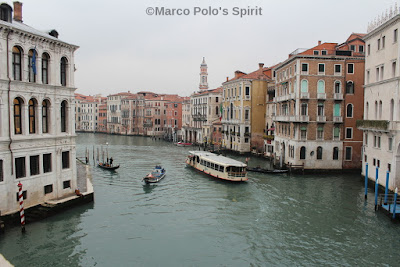 |
| Vaporetto and gondola on the Grand Canal |
It will not be so romantic, but it will save you lots of money. After all you can always get on the next gondola and re-experience it all.
For more information on the Venezia Unica Card (for transports and museums), click here.
DIALECT AND MEANING
Venetians speak their own version of Italian, they are known to walk quickly, and to be easily irritated.If you are strolling around and a busy Venetian shouts to you: "Ocio ae gambe" (Watch your legs), or "Ocio ae calse" (Watch your tights), it actually means: "Get out of the way. You are in the way". It is usually yelled out by porters or people carrying luggage when there is no room to pass through.
Remember, the calle are usually crowded and narrow in Venice. Keep right, don't walk in the middle of the calle.
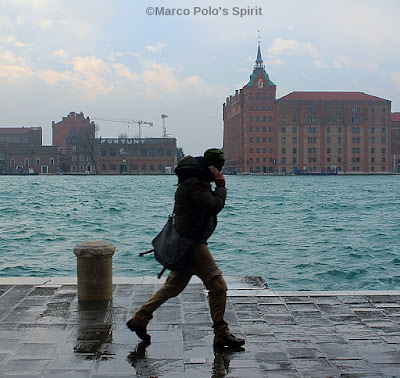 |
| Venetians are always in a hury, on the phone or pushing carts |
GONDOLA TRAGHETTO (FERRY-GONDOLA)
How do you cross the Grand Canal if there is no bridge? Get on a "barchéta da tragheto" (in Venetian, a ferry gondola). They are gondolas, but they are used to cross over to the other side of the "Canalasso" (the Grand Canal in Venetian).
You turn up at the stations where you can get on them (Rialto, Sant'Angelo, San Gregorio, Punta della Dogana, Riva del Vin, Calle Vallaresso). Generaly they run from 8.30 am to 7 pm. You pay 2 euros per person in coins to the gondoliers.
HIGH TIDE
Venice is built on water. In winter high tide is a fact and a problem, and depending on the tide height, some parts of Venice can flood. The municipality of Venice has set wooden catwalks in the areas where floodings occur.
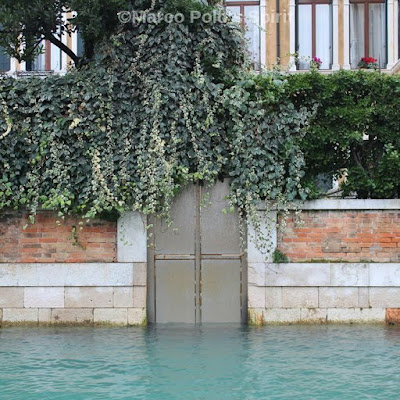 |
| High tide in Venice |
Take a look at the Tide Centre which monitors daily Venice high tide, and find out more here.
LUGGAGE STORAGE
Whenever you can, leave your luggage at your hotel. However, if you are looking for a place where to drop you luggage (in Italian "deposito bagagli", you can try these luggage storages in Piazzale Roma (bus terminal and car park), at Venice Santa Lucia train station and close to Rialto.
MUSEUMS
The first Sunday of each month (4th February 2018) the Italian national museums managed by the Italian Ministry of Culture and Heritage (in Italian MiBAC) are free. Check out before you go on this website.
SHOES
Wear comfortable shoes, and walk: it seems commonplace to say, but Venice transport network gets packed at Carnival, especially the local water buses. If you can, walk rather than catching them and waiting for hours. You will save time and money.
Another tip is walking away from the busy tourist flow that gets you trapped into the usual calles (the ones that display a yellow-brown sign saying "Ferrovia" -station- or "San Marco"). Don't follow the flow. After all, wandering around and getting lost in Venice are the best part!
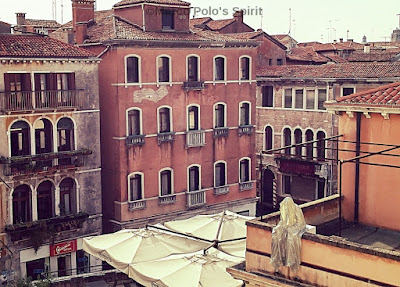 |
| Get away from the crowds...no so much though! |
STREETS
The streets in Venice are called "calle". When you walk, stick to your right. The calles are narrow and you get stuck very easily. However, at Carnival the local police may decide that the busiest calles become one-way streets only.
TIMINGS
Get to the celebrations very early. The places will get pbusy soon. If you want to gain the best spot, go early. Book restaurants, and theatres as early as you can. The same is also true if you want to visit a museum or attend a parade: to avoid queues, go there well ahead of the official time.
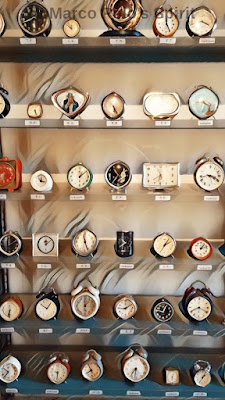 |
| The secret is to get to the Carnival events well ahead of time! |
The other thing to bear in mind is that the local police may decided that for security reasons the free access to the main events is limited.
GETTING THERE AND AROUND
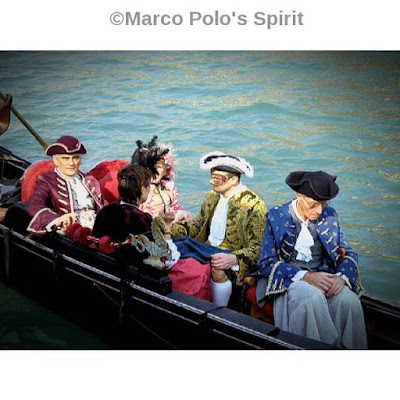 |
| Gondola with masked people on board |
Venice is just 15 km from Venice Marco Polo airport (20 minutes by car), and 40 km from Treviso Airport (roughly half an hour depending on the traffic). Cars are not necessary and aren't allowed in Venice.
However, it is necessary if you wish to visit fascinating areas of the Veneto region such as the villages on the Prosecco wine hills or the Dolomites.
By car: if you get into Venice Marco Polo airport, click here to rent a car in Venice. If you fly into Treviso Airport, click here to rent a car in Treviso.
In Venice the easiest parking lot is at the multi-storey car park called Venice Tronchetto Parking where you have to leave your car. No cars are allowed in Venice.
Alternatively leave your car in Mestre (the city before Venice) and get on the train and get off at Venezia Santa Lucia, the terminal station.
You have one more option: you can catch a bus from Mestre train station to Venice, and you will get off in Piazzale Roma, Venice buses terminal hub. From Piazzale Roma you need to walk, catch a water bus or a private water taxi to reach your destination.
By train: Venice is well-connected to most Italian cities. For information on the Italian railway tickets and timetables, click here. Mestre is the city before Venice, and a main train hub.
At Carnival there are extra trains that reach the hinterland (Mestre, and Treviso) if you wish to stay late.
On foot: the best way to visit Venice is walking. If you don't want to walk, you need to get the local water buses, or a private a water taxi.
If you need to cross over the Grand Canal without swimming or long-jumping, get on a gondola-traghetto (further details on this post on the top tips section).
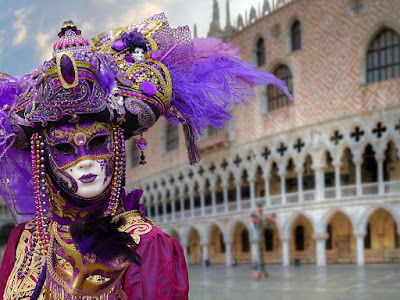 |
| Purple mask posing opposite the Doges's Palace in Saint Mark's Square |
